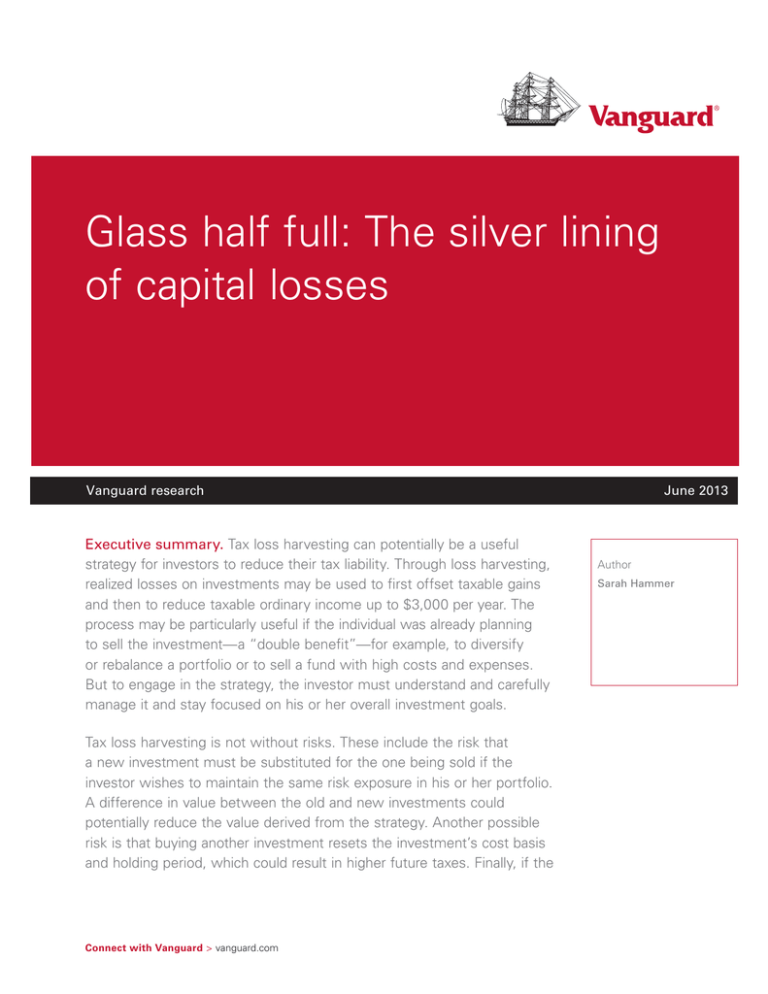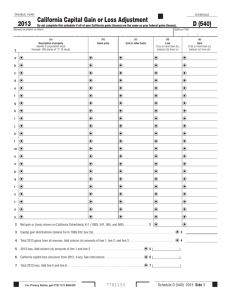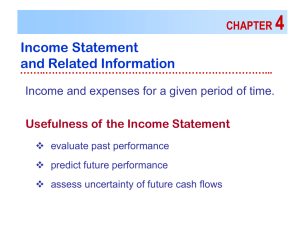Glass half full: The silver lining of capital losses
advertisement

Glass half full: The silver lining of capital losses Vanguard research Executive summary. Tax loss harvesting can potentially be a useful strategy for investors to reduce their tax liability. Through loss harvesting, realized losses on investments may be used to first offset taxable gains and then to reduce taxable ordinary income up to $3,000 per year. The process may be particularly useful if the individual was already planning to sell the investment—a “double benefit”—for example, to diversify or rebalance a portfolio or to sell a fund with high costs and expenses. But to engage in the strategy, the investor must understand and carefully manage it and stay focused on his or her overall investment goals. Tax loss harvesting is not without risks. These include the risk that a new investment must be substituted for the one being sold if the investor wishes to maintain the same risk exposure in his or her portfolio. A difference in value between the old and new investments could potentially reduce the value derived from the strategy. Another possible risk is that buying another investment resets the investment’s cost basis and holding period, which could result in higher future taxes. Finally, if the Connect with Vanguard > vanguard.com June 2013 Author Sarah Hammer investor harvests losses greater than gains plus $3,000 of ordinary income, he or she may not have future capital gains to offset those losses, or future tax rates might change in a way that reduces or negates the value of harvesting losses today. Therefore, it is generally not recommended to harvest losses in excess of current-year gains plus an amount to offset ordinary income.1 Tax loss harvesting can potentially provide investors with the opportunity to reduce their tax liability, because realized losses on investments can be used to first offset taxable gains and then to reduce ordinary income up to $3,000 per year. Moreover, the strategy may provide a “double benefit” if the investor was already planning to sell—for example, to diversify a position, rebalance a portfolio, or eliminate a high-cost fund. However, the investor should be aware of possible risks, including the risk involved if he or she chooses a replacement investment, the risk of resetting one’s basis, and possible difficulties if losses greater than gains plus $3,000 are harvested. In this paper, we review the process of tax loss harvesting, its potential benefits and risks, the possible implications of the wash sale rule, and some final considerations. As with all tax matters, we recommend that individuals consult their tax advisor to evaluate their particular situation. Tax loss harvesting involves certain risks, including, among others, the risk that the new investment could perform worse than the original investment, and that transaction costs could offset the tax benefit. There may be tax implications. Consult your firm’s tax advisor before taking action. 1 Tax loss harvesting is one of many available strategies for managing taxes, in addition to prudent asset location, tax diversification, and tax-efficient investing. Individuals should consult their tax advisor to evaluate their particular situation. This note is not intended to and does not constitute legal or tax advice, and it cannot be used for the purpose of avoiding tax penalties that may be imposed under the Internal Revenue Code. 2 The treatment of capital gains and losses In understanding tax loss harvesting, it’s important to know the following terminology (see Figure 1). A capital “gain” is the profit that an investor realizes when selling an investment at a higher price than he or she originally paid.2 The price originally paid for the investment is known as its “cost basis.” Gains on the sale of an investment held for one year or less are considered “short-term” and are taxed at ordinary income tax rates. Gains on the sale of an investment held more than one year are considered “long-term” and are taxed at the long-term capital gains tax rate, currently 15% or 20%, depending on the investor’s marginal income tax bracket.3 The “character” of the gain refers to whether it is long-term or short-term. Taxation of capital gains is based on the net amount of gains realized by the investor over the course of the year. Thus, losses realized on the sale of investments held in taxable accounts may be first Figure 1. deducted from gains in a procedure known as “netting.” As a result, every dollar of realized losses may reduce current-year tax liability on realized gains by 0% to 39.6%, depending on the character of the gain and the investor’s ordinary income tax bracket.4 After all gains have been offset, up to $3,000 of any remaining realized losses may be deducted against ordinary income. If any realized losses remain after offsetting gains and deducting $3,000 against ordinary income, they may be carried forward indefinitely for use in future tax years.5 However, since future portfolio positions and tax rates are unknown, it is generally not recommended to harvest losses in excess of current-year gains plus an amount to offset ordinary income. Netting losses against gains To take advantage of tax loss harvesting, the investor must net gains and losses. This can occur in two stages (see Figure 2, on page 4). Definitions Gain. Profit realized when an investment is sold at a higher price than that originally paid. Character of gain. Whether a gain is long-term or short-term. Short-term. Held for one year or less. Long-term. Held for more than one year. Netting. Deducting losses realized on the sale of investments from gains. Cost basis. Original price paid for an investment. Source: Vanguard. 2 I.R.C. Section 1001a. See also I.R.C. Section 1091. 3 The American Taxpayer Relief Act of 2012 (ATRA) provides for a 20% long-term capital gains tax rate for taxpayers in the 39.6% marginal income tax bracket, a 15% long-term capital gains tax rate for taxpayers in the 25%, 28%, 33%, or 35% brackets, and a 0% long-term capital gains tax rate for taxpayers in the 10% or 15% marginal income tax brackets. 4 The ATRA provides for marginal income tax brackets up to 39.6%. This research note does not evaluate the potential implications of the Medicare investment surtax, which would likely also apply to capital gains for investors in the highest income tax bracket. As always, we recommend that individuals consult with their tax advisor to discuss the implications and complexities of their personal tax situation. 5 Losses carried forward into future tax years “retain their character,” meaning that in future tax years, short-term losses are considered to be short-term and long-term losses are considered to be long-term. State tax treatment may differ from federal tax treatment. Investors should consult their tax advisor regarding rules for carryover losses after death. 3 Figure 2. Netting losses against gains Stage one: Stage two: • Short-term gains may be netted against short-term losses. • Short-term gain or loss may then be netted against long-term gain or loss. • If short-term gains exceed short-term losses, the investor has a net short-term gain. • Net losses of either type (short- or long-term) may be deducted against either type of gain (short- or long-term). • If short-term losses exceed short-term gains, the investor has a net short-term loss. • The investor does the same for long-term gains and losses. • If the investor has both a net short-term gain and a net long-term gain, the former is taxed as ordinary income and the latter is subject to the lower longterm capital gains tax. A tip: • It is generally preferable to use net losses to offset short-term gains or ordinary income and not to offset long-term gains with short-term losses. This is because both short-term gains and ordinary income are taxed at ordinary income tax rates, rather than the lower capital gains tax rate for long-term gains. Source: Vanguard. See also IRS Publication 550 (2012), Investment Income and Expenses. Example Figure 3 provides an example of tax loss harvesting. Suppose an investor in the 28% income tax bracket has an Investment A with an embedded long-term gain of $10,000 and an Investment B with an embedded loss of $7,000. He or she wishes to sell Investment A, in which case he or she realizes the gain of $10,000. Ordinarily, the investor would pay tax of $1,500 (15% long-term capital gains rate x $10,000). However, if he or she also chooses to sell Investment B (for example, because he or she needs to diversify), realizing a loss of $7,000, then he or she only has a net gain of $3,000 ($10,000 in longterm gains – $7,000 in losses = $3,000) and only owes tax of $450 (15% long-term capital gains rate x $3,000).6 Figure 3. Simple example of tax loss harvesting a. Investment A: Long-term gain (realized) b. Investment B: Embedded loss (harvested) $10,000 $7,000 c. Tax due without loss harvesting (= 15% x (a)) $1,500 d. Net gain if losses are harvested (= (a) – (b)) $3,000 e. Tax due if losses are harvested (= 15% x (d)) $450 Source: Vanguard. 6 This example assumes that the investor meets the holding period requirements for long-term capital gains and an applicable long-term capital gains tax rate of 15%. It does not take into account state or local taxes, the Medicare investment surtax, fund fees or expenses, or the potential impact of net gains on adjusted gross income. Finally, the example assumes that the loss was not disallowed due to the wash sale rule or for any other reason. This is a hypothetical example that does not represent the return on any particular investment. 4 Additional tax benefits may be realized if tax loss harvesting opportunities are used regularly. As noted, the strategy may be particularly useful if the investor was already planning to sell the investment, for example to diversify or to sell a fund with high costs and expenses. Moreover, it can potentially be used to reduce tax liability on a number of common portfolio management activities, such as rebalancing, forced realizations, capital gain distributions, or merger and acquisition activities. Potential benefits over time A simple example can illustrate the possible benefits of tax loss harvesting over time (see Figure 4).7 Suppose an investor purchased a security for $100,000 several years ago. It is now worth $90,000 (a loss of $10,000), and he or she has already realized $10,000 in capital gains for the current tax year. The investor is in the 39.6% tax bracket and therefore pays 20% tax on long-term capital gains. Tax loss harvesting can potentially offset this tax liability. If the gains realized in the current year were short-term, tax due would be $3,960 (39.6% x $10,000). If they were long-term, tax due would be $2,000 (20% x $10,000). If the investor makes a one-time decision to harvest losses and then holds the investment for five more years before liquidating it and paying tax on future gains, this would ultimately net $2,923 versus paying the tax on the short-term gains—a benefit of approximately 0.56%. Likewise, a one-time decision to harvest losses would net the investor $486 versus paying the tax on the long-term gains, a benefit of approximately 0.09%. While the benefits may seem marginal in this example, it’s important to keep in mind that they are derived from a one-time decision to harvest losses. Figure 4. Benefits of tax loss harvesting over time $112,000 $109,406 $109,892 109,000 $106,969 106,000 103,000 100,000 With taxes paid on short-term gains With taxes paid on long-term gains With tax loss harvesting Final market value of investment Source: Vanguard. Notes: The example assumes the investor is in the 39.6% tax bracket, pays 20% long-term capital gains tax on qualified long-term capital gains, and will also pay 20% long-term capital gains tax five years from now. It further assumes a 5% annual growth rate over five years and no dividends. It does not take into account state or local taxes, the Medicare investment surtax, fund fees or expenses, the potential impact of net gains on adjusted gross income, or potential effects of the wash sale rule, and it assumes no additional taxes are due on the investment before final liquidation. Returns are calculated based on final market value. Individuals should consult their tax advisor about their particular situation. This is a hypothetical example that does not represent the return on any particular investment. Fi 7 Note that this example does not take into account any potential implications of the Medicare investment surtax, which would likely apply. As always, we recommend that individuals consult with their tax advisor to discuss the implications and complexities of their personal tax situation. 5 Beware of the wash sale rule If an investor does choose to harvest losses, he or she may choose to attempt to replace the security sold with securities that have similar risk exposure characteristics. The availability of ETFs in a wide range of asset classes may provide opportunities to do so, potentially allowing the individual to continue to benefit if the investment appreciates in value. However, the replacement fund’s performance may not be consistent with that of the original investment. If the investor does replace the lots sold, he or she must be cognizant of the “wash sale rule,” which prohibits claiming a taxable loss on a security if he or she sells it and buys a “substantially identical” security 30 days before or after the sale. If the investor does engage in a wash sale, the loss on the lots sold will be disallowed and added to the cost basis of the newly purchased security, and the holding period of the new purchase will be adjusted to include the holding period of the lots that were sold for the loss. The IRS has not provided a definition of what constitutes a “substantially identical” security. Thus, the investor should consult his or her tax advisor on this matter.8 Potential risks One risk of tax loss harvesting is that a new investment must be substituted for the one being sold if the investor wishes to attempt to maintain the same risk exposure in a portfolio. A difference in value between the old and the new investment could result in a reduction in the value derived from the strategy. Another risk is that buying another investment resets the investment’s cost basis and holding period, which could potentially result in a reduction or elimination of the benefit of tax loss harvesting. This can happen in two ways. First, if the individual sells an investment and purchases a similar one, thus resetting the cost basis lower, but capital gains or ordinary income tax rates rise, the future tax liability could be higher than the benefit realized by harvesting losses today. Second, if the investor sells an investment, purchases a similar one, but then resells the new purchase in less than one year, he or she must pay the higher ordinary income tax rate on any realized gains. Additionally, if the individual harvests losses greater than gains plus $3,000 of ordinary income, he or she must recognize that there may not be future capital gains to offset any losses carried forward or that tax rates might change in a way that would reduce or negate the value of harvesting losses today. Therefore, it is generally not recommended to harvest losses greater than current-year gains plus an amount to offset ordinary income. Finally, the investor must realize that because harvesting losses affects his or her adjusted gross income (AGI), it therefore could affect the applicability of other tax provisions, such as the Personal Exemption Phaseout (PEP), the Pease limitation on itemized deductions, or the alternative minimum tax. Other potential issues to be aware of include the need to further rebalance a portfolio, complications of dividend distributions,9 and administrative hassle or transaction fees. 8 I.R.C. 1091. 9 Under IRS rules, “qualified dividends” are dividends that meet certain requirements, including a minimum holding period, to be taxed at the lower long-term capital gains tax rate rather than ordinary income tax rates. Sale of an investment may result in disqualification of qualified dividends, which may outweigh the benefit of tax loss harvesting. 6 Conclusion Tax loss harvesting can be a useful tool to reduce tax liability, particularly if an investor is already planning to sell an investment. However, he or she should stay focused on the overall investment, wealth management, and tax planning. When considering whether to harvest losses, an investor should think about many factors, including: • The amount and nature of the gain incurred on the investment; • The applicable capital gains tax rate, marginal income tax rate, and the possible benefits of offsetting either gains or ordinary income; • Whether he or she can or wishes to replace the investment being sold; • The possible implications of the wash sale rule, which can prevent an investor from claiming any benefit of tax loss harvesting; • If the investment sold is replaced, the effect of resetting the investor’s cost basis and holding period; • The effect of harvesting losses on the investor’s adjusted gross income; • Whether the loss harvested will result in a loss carryforward beyond the current tax year, or whether the investor already has an existing loss carryforward from previous years; • Possible complications posed by dividend distributions, administrative hassle, or transaction fees. 7 P.O. Box 2600 Valley Forge, PA 19482-2600 Connect with Vanguard® > vanguard.com Vanguard research > Vanguard Center for Retirement Research Vanguard Investment Strategy Group E-mail > research@vanguard.com For more information about Vanguard funds, visit vanguard.com or call 800-662-2739 to obtain a prospectus. Investment objectives, risks, charges, expenses, and other important information about a fund are contained in the prospectus; read and consider it carefully before investing. © 2013 The Vanguard Group, Inc. All rights reserved. Vanguard Marketing Corporation, Distributor. ICRGHF 062013






